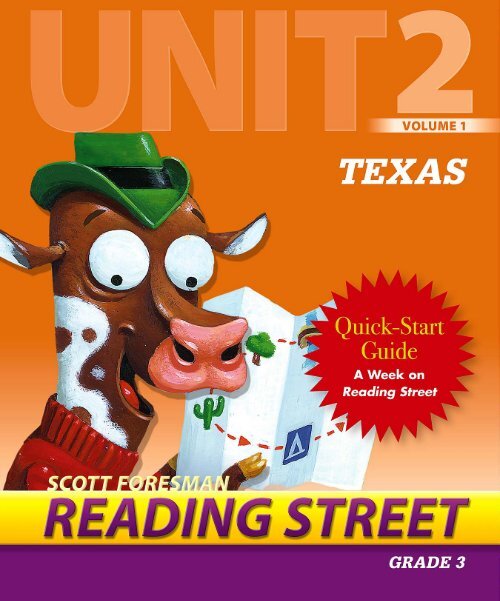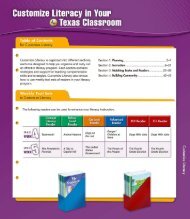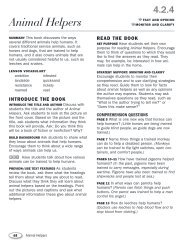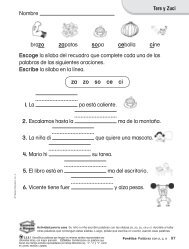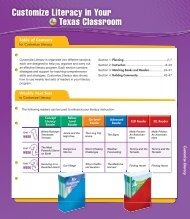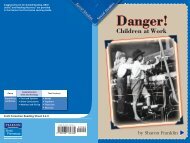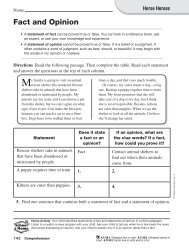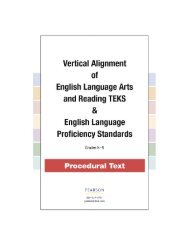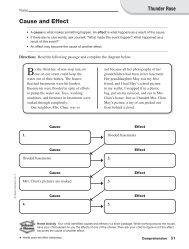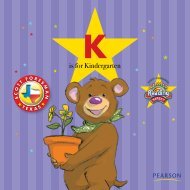Iguana - Reading Street Texas
Iguana - Reading Street Texas
Iguana - Reading Street Texas
You also want an ePaper? Increase the reach of your titles
YUMPU automatically turns print PDFs into web optimized ePapers that Google loves.
SmallGroup TimePacing SmallGroup Instruction5-Day PlanDAY 1DAY 2DAY 3DAY 4DAY 5• Reinforce the concept• Read Leveled ReadersConcept LiteracyBelow Level• Compare andContrast• Visualize15–20 min• Revisit Student Editionpp. 240–247• Unfamiliar Words• Revisit Student Editionpp. 248–255• Practice Retelling• Read/Revisit StudentEdition pp. 260–263• Reread for fluency• Reread LeveledReadersBuild Background■ Reinforce the Concept Reinforce the weekly question How do you know if asolution is a good solution? We can figure out if a solution is a good solution ifit solves the problem without causing new problems for ourselves or for otherpeople. When did you find a good solution to a problem you were having witha friend, brother, or sister? How did you solve the problem in a way that helpedeveryone? (Students may remember sharing toys, taking turns at games, orcompleting chores together.) Discuss the words on the concept map on p. 233.Review Decodable Practice Reader 7A■ Before <strong>Reading</strong> Review the words on p. 49 of DecodablePractice Reader 7A. Then have students blend thesewords from the text: supermarkets, cider, sorting, loaded,and jelly. Be sure students understand the meaning of suchwords as cider. Guide students through the text by doing apicture walk.• Practice phonics skills• Blending practice• Reread for fluencyDAY13- or 4-Day PlanDAY 1DAY 2DAY 3DAY 4• Reinforce the concept• Read Leveled Readers• Compare andContrast• Visualize• Revisit Student Editionpp. 240–247• Unfamiliar Words• Revisit Student Editionpp. 248–255• Practice Retelling• Read/Revisit StudentEdition pp. 260–263• Reread for fluency• Reread LeveledReaders3-Day Plan: Eliminate the shaded box.TEKS3.31.A.2 Participate in teacher-led discussions by answering questions with appropriate detail.DI•26 Smart Solutions • Unit 2 • Week 2
SmallGroup TimeReinforce ComprehensionDAY2Compare and ContrastAs you read, think about whatis alike and what is different.AlikeDifferentEI•5Skill Compare and Contrast Reviewwith students Envision It! p. EI•5 on compareand contrast. Then use p. 236 to review thedefinitions of compare and contrast. Comparingmeans telling how two or more things are alike.Contrasting means telling how two or morethings are different. Clue words such as like oras show comparisons. Clue words such as butor unlike show contrasts.240I WannaBY KAREN KAUFMAN ORLOFFILLUSTRATED BY DAVID CATROWRealistic Fiction tells a made-up story thatcould really happen. Read this story to findout if Alex can persuade his mom to let himhave an iguana.<strong>Iguana</strong>Question of the WeekHow do you know if asolution is a good solution?241Student Edition p. EI•5More <strong>Reading</strong>Use additional LeveledReaders or other texts atstudents’ instructional levelsto reinforce this week’s skillsand strategies. For textsuggestions, see the LeveledReader Database or theLeveled Readers Skills Charton pp. CL 24–CL 29.Strategy Visualize Review the definition of visualize. Remind students to usethe details in the letters to create pictures in their mind of the characters andevents. Visualizing will help them make comparisons and contrasts betweencharacters in the story, characters in other stories, and people in real life. Foradditional support, refer students to Envision It! p. EI•27.Revisit I Wanna <strong>Iguana</strong> on pp. 240–247. As students read, have them apply thecomprehension skill and strategy to the story.• How is Alex’s problem like the problem of many other children his age? (Hereally wants a pet and must convince his mother to say yes.)• How is the pet Alex wants different from pets children usually want? (Childrenusually want kittens or puppies. Alex wants an iguana.)• What difference between hamsters and iguanas is important to Alex? (<strong>Iguana</strong>sare cuter.)• According to Alex’s mom, how are tarantulas and iguanas alike? (They are bothquiet and ugly.)Use the During <strong>Reading</strong> Differentiated Instruction for additional support forstruggling readers.MONITORPROGRESSIf… students have difficulty reading along with the group,then… have them follow along as they listen to the AudioText.TEKS★ Compare and contrast ideas and information.3.10.A.1 Identify language that creates a graphic visual experience.DI•28 Smart Solutions • Unit 2 • Week 2
Envision It! AnimationsReinforce Vocabulary■ Reread for Fluency Use Decodable PracticeReader 7A.eSelectionI WannaBY KAREN KAUFMAN ORLOFFILLUSTRATED BY DAVID CATROWDAY<strong>Iguana</strong>■ Decoding Multisyllabic Words Write iguanaand model how to decode when there areno meaningful parts. I see a chunk at theRealistic Fiction tells a made-up story thatbeginning of the word: i. I see a chunk in thecould really happen. Read this story to findQuestion of the Weekout if Alex can persuade his mom to let himHow do you know if ahave an iguana.solution is a good solution?middle: gua. I see a chunk at the end: na. I240241say each chunk slowly: i gua na. I say thechunks fast to make a whole word: iguana. Iknow that word. An iguana is a type of lizard. Use the Multisyllabic Word routineon p. 2 of Routines Flip Chart to help students read these other words from thestory: sensitive, compassionate, adorable, mention, trophies, mature, reptile,concerned, and exactly.Unfamiliar Words/Context Clues Say and point out the word compassionateon the second page of text. On the previous page, Alex says Lurch will eat theiguana if Stinky takes it. Alex signs the letter “Your sensitive son.” Alex is tryingto show his mother that he is caring. I think compassionate must mean “showingfeelings for another’s pain or problems.” I will check in the dictionary to be sure.■ Revisit I Wanna <strong>Iguana</strong> on pp. 248–255. Review Words! on p. W•7. Encouragestudents to use context clues to figure out the meaning of any unfamiliar wordsin the story. Ask: What does mature mean? (“grown up, adult”) What contextclues did you use to figure out the meaning? (“15 years,” “I’ll be married bythen,” the illustration of a fully grown iguana and a grown-up Alex)Use the During <strong>Reading</strong> Differentiated Instruction for additional support forstruggling readers.DifferentiatedInstruction3Context CluesRead the words before and after a word thatyou don’t know to help you make sense of it.I couldn’t decidewhat to wear! Thered, blue, green, orfuchsia dress?Student Edition p. W•7Strategic InterventionMore <strong>Reading</strong>Use additional LeveledReaders or other texts atstudents’ instructional levelsto reinforce this week’s skillsand strategies. For textsuggestions, see the LeveledReader Database or theLeveled Readers Skills Charton pp. CL 24–CL 29.W•7MONITORPROGRESSIf… students have difficulty reading along with the group,then… have them follow along as they listen to the AudioText.TEKS3.4.B.1 Use context to determine the relevant meaning of unfamiliar words.I Wanna <strong>Iguana</strong>DI•29
TEKSINTERNET GUYe -mail address hereGame on Saturdayhttp://www.url.hereSmallGroup TimeGrade 3RetellingCardsISBN-13:978-0-328-38592-8ISBN-10:0-328-38592-1Practice Retelling■ Retell Guide students in using the RetellingCards to retell important ideas in I Wanna<strong>Iguana</strong> in order. Prompt students to includeimportant details.• What does Alex want from his mom?(He wants permission to take Mikey’s petiguana when Mikey moves.)• How does Alex finally gets his mother toagree? (He says he will feed the iguana, give it water, and clean its cage.)If students struggle, model a fluent retelling.Genre Focus26021st Century SkillsE-mail Texting is fun butemail can be even better.Share documents and workon a common project inschool. Email skills get youready for the world of work.Yes, email can be prettyuseful!The letter e in e-mailstands for “electronic.”An e-mail is a messagesent by computer overthe Internet.E-mail lets you quicklycommunicate withpeople all over theworld. Like letters,they can be formalor informal.Communicationchanges when youattach videos or photos.Read “The Big SoccerGame. ” Comparethe language inthese e-mails with thelanguage you wouldread in a text messageor a web-based newsarticle.The BigSoccerGameFrancisco and Jos é used to attendschool together until Jos é moved. Theyalso played together on the soccerteam. Jos é knows Francisco needs someencouragement and support because hehas a big soccer game coming up. Eventhough the two friends do not go to thesame school anymore, they can keep intouch using e-mail.DAYFrancisco used his e-mail provider to write tohis friend , Jos é.The e-mail address of theperson you are writing togoes here.Dear Jos é,How do you like your new school? I wish youwere still playing on our soccer team. We have ahuge game on Saturday and could really use youas our goalie. Maybe you could come and cheerus on. We are playing our rival, the Jets.Go Tigers!Sometimes, you are writingto a friend so your closingFranciscocan be casual or less formal.This e-mail would havebeen shortened if Franciscohad sent it as a text!4261■ Before <strong>Reading</strong> or Revisiting “The Big Soccer Game” on pp. 260–263, readaloud the genre information about e-mails on p. 260. Read the rest of the panel.Then have students locate the message box where the body of the e-mailmessage appears.■ During <strong>Reading</strong> or Revisiting Have students perform a choral reading of theselection. Point out the boxed captions that explain the different parts of the e-mails.• Where should Francisco type in José’s e-mail address? (next to To: at the topof the e-mail)• Why is Francisco writing to José? (He wants José to come to his soccer gameand cheer for his old team.)■ After <strong>Reading</strong> or Revisiting Have students share their reactions to theselection. How is I Wanna <strong>Iguana</strong> similar to “The Big Soccer Game”? (Both area series of messages.) How are the two selections different? (I Wanna <strong>Iguana</strong>is a series of letters, while “The Big Soccer Game” is a series of e-mails. Oneselection includes illustrations, while the other includes photographs.)MONITORPROGRESSIf… students have difficulty reading along with the group,then… have them follow along as they listen to the AudioText.TEKS3.16.A Understand how communication changes when moving from one genre of media to another.DI•30 Smart Solutions • Unit 2 • Week 2
Text eSelection TKeReadersDifferentiatedInstruction5DAYStrategic InterventionConcept Literacy Reader■ Model Model the fluency skillsof expression and punctuationcues for students. Ask studentsto listen carefully as you readaloud the first two pages ofWhich Way Is Better? Readonce with expression, beingcareful to pause at the end ofeach sentence. Then read thepages rapidly in a monotone,with no pauses. Have studentstell which version soundedbetter.■ Fluency RoutineBy Ellen CatalaWhich Way Is Better?1. Have students reread passages from Which Way IsBetter? with a partner.2. For optimal fluency, students should reread threeto four times.3. As students read, monitor fluency and providecorrective feedback. Have students note theexpression in your voice and how you usecommas and end punctuation as signals to pause.See Routines Flip Chart for more help with fluency.■ Retell Have students retell Which Way Is Better?Prompt as necessary.Below-Level Reader■ Model Ask students to listencarefully as you read aloud thefirst two pages of Buddy Goes toSchool, emphasizing expressionand punctuation cues.■ Fluency Routine1. Have students rereadpassages from Buddy Goesto School with a partner orindividually.2. For optimal fluency, studentsshould reread three to four times.Buddy Goesto SchoolBuddy Goes to School3. As students read, monitor fluency and providecorrective feedback. Discuss how readingexpressively and pausing for punctuation canmake a story more enjoyable and easier tounderstand.See Routines Flip Chart for more help with fluency.■ Retell For additional practice, have students retellBuddy Goes to School page by page using theillustrations. Prompt as necessary.• How does Buddy change during the book? (In thebeginning, he doesn’t behave. At the end, he’sobedient.)MONITORPROGRESSIf… students have difficulty reading fluently,then… provide additional fluency practice by pairing nonfluentreaders with fluent ones.TEKS3.3.A.1 Read aloud grade-level appropriate text with fluency.I Wanna <strong>Iguana</strong>DI•31
SmallGroup TimePacing SmallGroup Instruction5-Day PlanDAY 1DAY 2DAY 3DAY 4DAY 5• Expand the concept• Read On-Level Reader• Compare andContrast• Visualize• Revisit Student Editionpp. 240–247• Unfamiliar Words• Revisit Student Editionpp. 248–255• Practice Retelling• Read/Revisit StudentEdition pp. 260–263• Reread for fluency• Reread On-LevelReader3- or 4-Day PlanDAY 1DAY 2DAY 3DAY 4• Expand the concept• Read On-Level Reader• Compare andContrast• Visualize• Revisit Student Editionpp. 240–247• Unfamiliar Words• Revisit Student Editionpp. 248–255• Practice Retelling• Read/Revisit StudentEdition pp. 260–263• Reread for fluency• Reread On-LevelReader3-Day Plan: Eliminate the shaded box.15–20 min.Build Background■ Expand the Concept Connect to the weekly question How do you know if asolution is a good solution? and expand the concept. Sometimes finding a goodsolution to a problem means making a decision between two difficult choices.Then it is important to ask, “What could happen if I make this choice?” and“What could happen if I make that choice?” Discuss the meaning of the wordson the concept map on p. 233.For a complete lessonplan and additionalpractice, see theOn-Level ReaderLeveled ReaderTeaching Guide.■ Before <strong>Reading</strong> <strong>Iguana</strong> Takes a Ride, have studentspreview the book by looking at the title, cover, and pictures.• Who are the characters in this book? (an iguana, acrocodile, and a frog)• Where does the story take place? (near or on a river)Have students create a Venn diagram to show thesimilarities and differences between the iguana andthe frog. Explain that students will complete their Venndiagrams as they read.■ During <strong>Reading</strong> Read aloud the first three pages of the book as students followalong. Then have them finish reading on their own. Remind students to adddetails that show how the iguana and frog are alike and different.• What problem do both the iguana and the frog have to solve? (They both haveto cross the river.)• How does each character respond to the crocodile’s offer? (The iguana can’tmake up his mind. The frog accepts.)■ After <strong>Reading</strong> Have partners compare their Venn diagrams.• Why wasn’t the iguana able to make up his mind? (Neither solution seemedgood to him.)• How does the fable relate to the weekly question How do you know if asolution is a good solution? (It shows that the wrong solution can have verybad consequences.)TEKS3.31.A.2 Participate in teacher-led discussions by answering questions with appropriate detail.DAY<strong>Iguana</strong> Takes a Ride1DI•32 Smart Solutions • Unit 2 • Week 2
eSelectionExpand ComprehensionSkill Compare and Contrast Use p. 236to review the definitions of compare andcontrast. For additional review, see Compareand Contrast on Envision It! p. EI•5. I will ask,“Whom does this character remind me of?”and “How is this like something I already knowabout?”eReadersStrategy Visualize Review the definitionof visualize and encourage students to createpictures in their minds of the characters, setting, and ideas as they read. Foradditional support, use the Extend Thinking questions during reading or referstudents to p. EI•27 of Envision It!Revisit I Wanna <strong>Iguana</strong> on pp. 240–247. As students read, have them look fordetails that will help them compare and contrast story elements.• Compare the structure of this story to that of other realistic fiction stories.(This story is told in a series of letters or notes. Most other stories are told inparagraphs with dialogue.)• What does Stinky’s house have that Alex’s house does not have? (a dog namedLurch)• Why does Alex think this difference should be important to his mom? (He wantshis mom to believe the iguana will be safer with him.)240I WannaBY KAREN KAUFMAN ORLOFFILLUSTRATED BY DAVID CATROWRealistic Fiction tells a made-up story thatcould really happen. Read this story to findout if Alex can persuade his mom to let himhave an iguana.DAY<strong>Iguana</strong>DifferentiatedInstructionQuestion of the WeekHow do you know if asolution is a good solution?2241AlikeCompare and ContrastAs you read, think about whatis alike and what is different.DifferentStudent Edition p. EI•5More <strong>Reading</strong>Use additional LeveledReaders or other texts atstudents’ instructional levelsto reinforce this week’s skillsand strategies. For textsuggestions, see the LeveledReader Database or theLeveled Readers Skills Charton pp. CL 24–CL 29.EI•5On-LevelTEKS★ Compare and contrast ideas and information.3.10.A.1 Identify language that creates a graphic visual experience.I Wanna <strong>Iguana</strong>DI•33
SmallGroup TimeExpand VocabularyDAY3Context CluesRead the words before and after a word thatyou don’t know to help you make sense of it.Unfamiliar Words/Context Clues Write theword compassionate as you say it aloud. Thenask:I WannaBY KAREN KAUFMAN ORLOFFILLUSTRATED BY DAVID CATROW<strong>Iguana</strong>• Where is this word used in the story? Whouses it? (Alex’s mom uses it in her first note.)I couldn’t decidewhat to wear! Thered, blue, green, orfuchsia dress?Student Edition p. W•7W•7• Why does Alex’s mom use this word? (Alextold her in his note that Lurch will eat theiguana if Stinky takes it. He signs his letter“Your sensitive son.”)240Realistic Fiction tells a made-up story thatcould really happen. Read this story to findout if Alex can persuade his mom to let himhave an iguana.Question of the WeekHow do you know if asolution is a good solution?241More <strong>Reading</strong>Use additional LeveledReaders or other texts atstudents’ instructional levelsto reinforce this week’s skillsand strategies. For textsuggestions, see the LeveledReader Database or theLeveled Readers Skills Charton pp. CL 24–CL 29.• Based on these context clues, what does compassionate mean? (“showingfeelings for another’s pain or problems”) Have students refer to a dictionary ifnecessary.Revisit I Wanna <strong>Iguana</strong> on pp. 248–255. Encourage students to use context cluesas they read the entire selection.• Where is the word mature used in the story? Who uses it? (Alex uses it in hisfourth note.)• Why does Alex use this word? (He wants his mom to know that he will be grownup by the time the iguana gets to be full size. The illustration shows a grown-upAlex and a fully grown lizard.)• Based on the context clues in the letter, what does mature mean? (“grown upor fully grown”) Again, have students refer to a dictionary if necessary. Remindstudents to look for context clues whenever they encounter an unfamiliar word.TEKS3.4.B.1 Use context to determine the relevant meaning of unfamiliar words.DI•34 Smart Solutions • Unit 2 • Week 2
TEKSINTERNET GUYe -mail address hereGame on Saturdayhttp://www.url.hereeSelectionDifferentiatedInstructionDAY4On-LevelPractice Retelling■ Retell To assess students’ comprehension,use the Retelling Cards. Monitor retelling andprompt students as needed.Genre Focus26021st Century SkillsE-mail Texting is fun butemail can be even better.Share documents and workon a common project inschool. Email skills get youready for the world of work.Yes, email can be prettyuseful!The letter e in e-mailstands for “electronic.”An e-mail is a messagesent by computer overthe Internet.E-mail lets you quicklycommunicate withpeople all over theworld. Like letters,they can be formalor informal.Communicationchanges when youattach videos or photos.Read “The Big SoccerGame. ” Comparethe language inthese e-mails with thelanguage you wouldread in a text messageor a web-based newsarticle.The BigSoccerGameFrancisco and Jos é used to attendschool together until Jos é moved. Theyalso played together on the soccerteam. Jos é knows Francisco needs someencouragement and support because hehas a big soccer game coming up. Eventhough the two friends do not go to thesame school anymore, they can keep intouch using e-mail.Francisco used his e-mail provider to write tohis friend , Jos é.The e-mail address of theperson you are writing togoes here.Dear Jos é,How do you like your new school? I wish youwere still playing on our soccer team. We have ahuge game on Saturday and could really use youas our goalie. Maybe you could come and cheerus on. We are playing our rival, the Jets.Go Tigers!Sometimes, you are writingto a friend so your closingFranciscocan be casual or less formal.This e-mail would havebeen shortened if Franciscohad sent it as a text!261Grade 3RetellingCardsISBN-13:978-0-328-38592-8ISBN-10:0-328-38592-1■ Before <strong>Reading</strong> or Revisiting “The Big Soccer Game” on pp. 260–263, readaloud the genre information about e-mails on p. 260. Explain that e-mails arean easy and fast way to communicate with friends and family. Have studentspreview “The Big Soccer Game” and set a purpose for reading.• How are the parts of an e-mail similar to or different from the parts of a regularletter? (alike—greeting, message, closing, signature; different—To: box,subject line, icons)• What is the purpose of the boxed text? (to help readers understand the partsof an e-mail)■ During <strong>Reading</strong> or Revisiting Have students read along with you while trackingthe print.• How is the story organized? (as a series of e-mails)• Why do you think Francisco used e-mail instead of regular mail? (A lettermight not reach José before the game.)■ After <strong>Reading</strong> or Revisiting Have students share their reaction to “The BigSoccer Game.” Then divide students into two groups. Have them conduct abrief debate about who is more persuasive: Alex or Francisco. Tell them touse details from I Wanna <strong>Iguana</strong> and “The Big Soccer Game” to compare andcontrast the characters and their problems and to support their choice of whichcharacter is more persuasive.TEKS3.16.A Understand how communication changes when moving from one genre of media to another.I Wanna <strong>Iguana</strong>DI•35
SmallGroup TimeOn-Level Reader■ Model Read aloud the first page of the On-Level Reader<strong>Iguana</strong> Takes a Ride, emphasizing expression andpunctuation cues.■ Fluency Routine1. Have students reread passages from <strong>Iguana</strong> Takes aRide with a partner.DAY52. For optimal fluency, students should reread passagesthree to four times.3. As students read, monitor fluency and provide correctivefeedback. Have students note the expressive quality ofthe reader’s voice and how punctuation can provide cues to expression andwhere to pause.See Routines Flip Chart if students need more help with fluency.■ Retell For additional practice, have students use illustrations as a guide to retell<strong>Iguana</strong> Takes a Ride. Prompt as necessary.• What is the iguana’s problem? (He needs to cross a river.)<strong>Iguana</strong> Takes a Ride• Why is it important to think about the possible outcomes of different choices?(Making the wrong choice can lead to a bad outcome. The frog makes thewrong choice and ends up getting eaten by the crocodile.)TEKS3.3.A.1 Read aloud grade-level appropriate text with fluency.DI•36 Smart Solutions • Unit 2 • Week 2
eReadersBuild Background■ Extend the Concept Extend the weekly question How do you know if asolution is a good solution? Sometimes finding a good solution to an ordinaryproblem, such as choosing a pet, becomes complicated because of unusualcircumstances. What circumstances can make such an ordinary problemdifficult? (people’s differing opinions, needs and wants, and living environment)Advanced ReaderFor a complete lessonplan and additionalpractice, see theLeveled ReaderTeaching Guide.■ Before <strong>Reading</strong> Puppy Problems, have students look atthe illustrations in the book and use them to predict whatwill happen in the text. After that, have students set apurpose for reading.■ During <strong>Reading</strong> Have students read the Advanced Readerindependently, and encourage them to think critically.• What makes choosing a dog a problem for Zoe and herfamily?Puppy Problems• How do you think these problems make Zoe feel about living in the governor’smansion?■ After <strong>Reading</strong> Have students review the concept map and explain how PuppyProblems helps students answer the weekly question How do you know if asolution is a good solution? Prompt as necessary.• What decision does Zoe make? Why does she make this choice?• In your opinion, do Zoe and her family find a good solution? Explain.• Based on this book and what you already know, why is it sometimes difficultto find a good solution?■ Now Try This Have small groups choose a type of pet and research how to feedand care for it. Students may choose a typical pet, such as a dog, cat, rabbit,or hamster. Others may choose a more exotic pet, such as an iguana, parrot,ferret, turtle, python, tropical fish, or potbellied pig. Each group should prepare ado’s and don’ts list of how to care for that animal. Groups should work on theirresearch and lists throughout the week.TEKS3.31.A.2 Participate in teacher-led discussions by answering questions with appropriate detail.DAYDifferentiatedInstruction1Pacing SmallGroup Instruction5-Day PlanDAY 1DAY 2DAY 3DAY 4DAY 5• Extend the concept• Read AdvancedReader• Compare andContrast• Visualize• Revisit Student Editionpp. 240–247• Unfamiliar Words• Revisit Student Editionpp. 248–255• 21st Century Skills:E-mail• Read/Revisit StudentEdition pp. 260–263• Reread for fluency• Reread AdvancedReader3- or 4-Day PlanDAY 1DAY 2DAY 3• Extend the concept• Read AdvancedReader• Compare andContrast• VisualizeAdvanced15–20 min• Revisit Student Editionpp. 240–247• Unfamiliar Words• Revisit Student Editionpp. 248–255• 21st Century Skills:E-mail• Read/Revisit StudentEdition pp. 260–263• Reread for fluencyDAY 4• Reread AdvancedReader3 Day Plan: Eliminate the shaded box.I Wanna <strong>Iguana</strong>DI•37
SmallGroup TimeMore <strong>Reading</strong>Use additional LeveledReaders or other texts atstudents’ instructional levelsto reinforce this week’s skillsand strategies. For textsuggestions, see the LeveledReader Database or theLeveled Readers Skills Charton pp. CL 24–CL 29.Extend ComprehensionDAYSkill Compare and Contrast Remindstudents that making comparisons means I WannaBY KAREN KAUFMAN ORLOFFILLUSTRATED BY DAVID CATROWtelling how two or more things are alike ordifferent. Sometimes an author will use wordssuch as like and unlike as clues. Most ofthe time readers have to think about whatRealistic Fiction tells a made-up story thatcould really happen. Read this story to findout if Alex can persuade his mom to let himthey read and what they already know abouthave an iguana.240people, places, things, and ideas. Think of thebook that you just read, Puppy Problems. Inyour opinion, how is Zoe like other girls her age? How is her life different?<strong>Iguana</strong>Question of the WeekHow do you know if asolution is a good solution?Strategy Visualize Review the definition of the strategy, and remind studentsto create mental pictures of characters, setting, and ideas as they read.Revisit I Wanna <strong>Iguana</strong> on pp. 240–247. As students read, they should trackdetails that can help them make comparisons and contrasts.• Alex and his mom compare an iguana to which other animals? Why do theymake these comparisons?2241• How will the iguana be different when it gets older? Why is this an importantidea for Alex to consider?During reading, use the Extend Thinking questions and the During <strong>Reading</strong>Differentiated Instruction for additional support.TEKS★ Compare and contrast ideas and information.3.10.A.1 Identify language that creates a graphic visual experience.DI•38 Smart Solutions • Unit 2 • Week 2
eSelectionExtend VocabularyUnfamiliar Words/Context Clues Reada sentence or a section of the selection thatcontains an example of an unfamiliar word. Forexample, read the first two pages, focusing onthe word compassionate.■ Revisit I Wanna <strong>Iguana</strong> on pp. 248–255.Challenge students to find other unfamiliarwords throughout the selection. For example,ask:240I WannaBY KAREN KAUFMAN ORLOFFILLUSTRATED BY DAVID CATROWRealistic Fiction tells a made-up story thatcould really happen. Read this story to findout if Alex can persuade his mom to let himhave an iguana.DAY<strong>Iguana</strong>DifferentiatedInstructionQuestion of the WeekHow do you know if asolution is a good solution?3241AdvancedMore <strong>Reading</strong>Use additional LeveledReaders or other texts atstudents’ instructional levelsto reinforce this week’s skillsand strategies. For textsuggestions, see the LeveledReader Database or theLeveled Readers Skills Charton pp. CL 24–CL 29.• What does mention mean on p. 244? (“say briefly”)• What does mature mean on p. 246? (“grown up”) Explain whether Alex seemsmature to you. (Some students may say that Alex is mature because he makesso many arguments in his letters and because he is persistent. Others may sayhe is immature because he wants to have his own way and because he ignoreshis little brother.)• What does concerned mean on p. 247? (“worried about”) Do you thinkAlex’s mom is really concerned, or is she joking? (Students should be able tounderstand based on Alex’s mom’s language and the funny illustration that sheis joking.)■ Creative Thinking Encourage students to think creatively about the selection.• What kind of letter might Alex write to his mom after he has taken care of theiguana for a few months?• If the iguana could write, what kind of letter might it send to Alex? To Alex’smom?TEKS3.4.B.1 Use context to determine the relevant meaning of unfamiliar words.I Wanna <strong>Iguana</strong>DI•39
TEKSINTERNET GUYe -mail address hereGame on Saturdayhttp://www.url.hereSmallGroup TimeGenre Focus■ Before <strong>Reading</strong> or Revisiting “The Big Soccer Game” on pp. 260–263,read aloud the panel information on e-mails. Then have students use thetext features to set a purpose for reading.the language inthese e-mails with thelanguage you wouldread in a text message■ During <strong>Reading</strong> or Revisiting Point out that people write e-mails for manyor a web-based newsarticle.260reasons. How is the form of Francisco’s e-mail like that of a friendly letter? (It"The Big Soccer Game"has a greeting, body, closing, and signature.) How are the e-mails betweenFrancisco and José alike and different from the notes between Alex and hismom? (Both are short and persuasive. The notes are probably handwritten. The e-mails are typed.)21st Century SkillsE-mail Texting is fun butemail can be even better.Share documents and workon a common project inschool. Email skills get youready for the world of work.Yes, email can be prettyuseful!The letter e in e-mailstands for “electronic.”An e-mail is a messagesent by computer overthe Internet.E-mail lets you quicklycommunicate withpeople all over theworld. Like letters,they can be formalor informal.Communicationchanges when youattach videos or photos.Read “The Big SoccerGame. ” CompareThe BigSoccerGameFrancisco and Jos é used to attendschool together until Jos é moved. Theyalso played together on the soccerteam. Jos é knows Francisco needs someencouragement and support because hehas a big soccer game coming up. Eventhough the two friends do not go to thesame school anymore, they can keep intouch using e-mail.DAYFrancisco used his e-mail provider to write tohis friend , Jos é.The e-mail address of theperson you are writing togoes here.4Dear Jos é,How do you like your new school? I wish youwere still playing on our soccer team. We have ahuge game on Saturday and could really use youas our goalie. Maybe you could come and cheerus on. We are playing our rival, the Jets.Go Tigers!Sometimes, you are writingto a friend so your closingFranciscocan be casual or less formal.This e-mail would havebeen shortened if Franciscohad sent it as a text!261■ After <strong>Reading</strong> or Revisiting Have students discuss in what ways e-mails are better or worse than telephonecalls, letters, voicemail messages, text messages, and face-to-face conversations.TEKS3.16.A Understand how communication changes when moving from one genre of media to another.■ Reread for Fluency Have students silently reread passages from the Advanced ReaderPuppy Problems. Then have them reread aloud with a partner or individually. As studentsread, monitor fluency and provide corrective feedback. If students read fluently on the firstreading, they do not need to reread three to four times. Assess the fluency of students inthis group using p. 265j.■ Retell Have students summarize the main idea and key details from the Advanced ReaderPuppy Problems.■ Now Try This Discuss students’ lists and encourage them to share their lists with the restof the class. Based on students’ research, which pets require the most care? Which petswould students like to own and why?DAYPuppy Problems5TEKS3.16.A Read aloud grade-level appropriate text with fluency.DI•40 Smart Solutions • Unit 2 • Week 2


